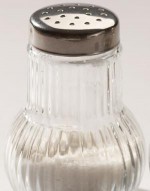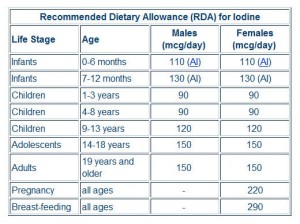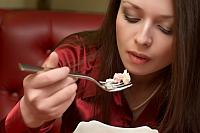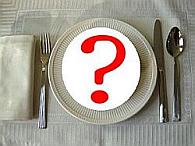Iodine is a necessary mineral for healthy function of mind and body. Iodine deficiency is not common in the U.S. and places with iodine addition to table salt and other food sources. Main symptoms of iodine deficiency are dry, scaly skin, constipation, fatigue, unusual weight gain, goiters, impaired thyroid function.
A typical US diet consumes 150-550 micrograms of iodine. The Recommended Daily Allowance (RDA) for adults is 80-200 micrograms a day. The group potentially at risk is pregnant women who do not have good prenatal care and do not regularly take their vitamin supplements. In recent years many people opt to follow a low sodium diet for blood pressure control and decrease heart disease risks. With decrease intake of table salt (primary iodine source) are you getting enough to prevent iodine deficiency?
Iodine cannot be stored in our bodies for long periods and must be consumed regularly. Most of us are able to eat enough to adequately meet our iodine need. In the US, iodine is added to table salt and is the primary food source of iodine.
These foods are good sources for a high iodine diet:
- Seafood, shellfish, ocean fish
- Cod, Sea bass, Haddock, Perch
- Kelp, other seaweed, sea vegetables
- Dairy products – milk, cheeses
- Plants grown in soil rich in iodine
- 1 teaspoon salt has ~400 microgram iodine
Always check with your doctor before taking an iodine supplement.
Good article on Iodine Nutrition Facts
Related posts:
Tips for Potassium Restricted Diet
Potassium Sources for High Potassium Diet
Potassium Rich Foods Decrease Health Risks
Salt Substitute and Sea Salt for Low Sodium Diet
Tips for Low Sodium Diet Plan




{ 0 comments… add one now }